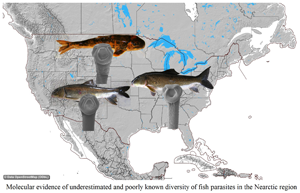Published online by Cambridge University Press: 12 May 2021

Monozoic tapeworms (Caryophyllidea) are dominant components of parasite communities of suckers (Catostomidae) in North America, with Biacetabulum Hunter, 1927 representing one of the more species-rich genera. Molecular (28S rDNA) and morphological (including scanning electron microscopy and histology) evaluation of newly collected tapeworms from different fish hosts revealed the existence of four similar (and three closely related) species of Biacetabulum. These four species differ from their congeners by having a long body (up to 48 mm long) with a very long, slender neck (its length represents ≥30% of total body length), a large, globular scolex with a prominent central acetabulum-like loculus on the dorsal and ventral sides, two pairs of shallow lateral loculi and a distinct, slightly convex apical disc, and a cirrus-sac that is situated between the anterior arms of the ovarian wings. Taken together, the morphological and molecular data and the host associations of these species provide evidence of their host specificity. Biacetabulum isaureae n. sp. occurs in notch clip redhorse, Moxostoma collapsum, in South Carolina (USA), B. longicollum n. sp. in silver redhorse, Moxostoma anisurum (type host), and golden redhorse, M. erythrurum, in Manitoba (Canada) and West Virginia (USA), B. overstreeti n. sp. in a spotted sucker, Minytrema melanops, in Mississippi, and B. hypentelii n. sp. in northern hogsucker, Hypentelium nigricans, in Tennessee (USA). The new species differ from each other in the number of postovarian vitelline follicles, the posterior extent of preovarian vitelline follicles and relative size of the cirrus sac.